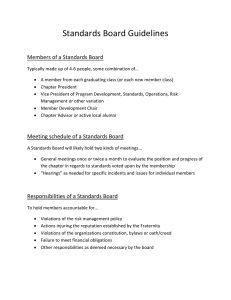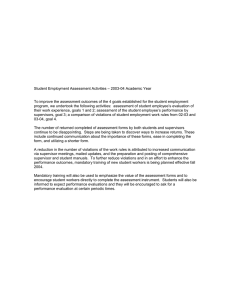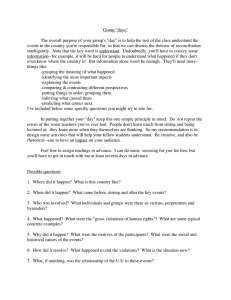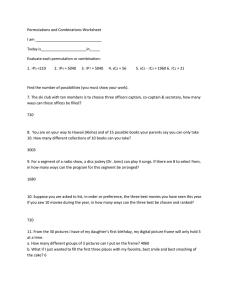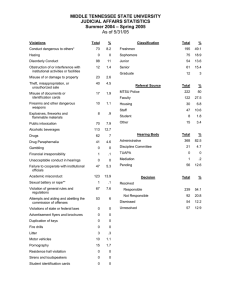Outline Using Accountability Theory to Reduce Unauthorized Data Access Gove N. Allen
advertisement
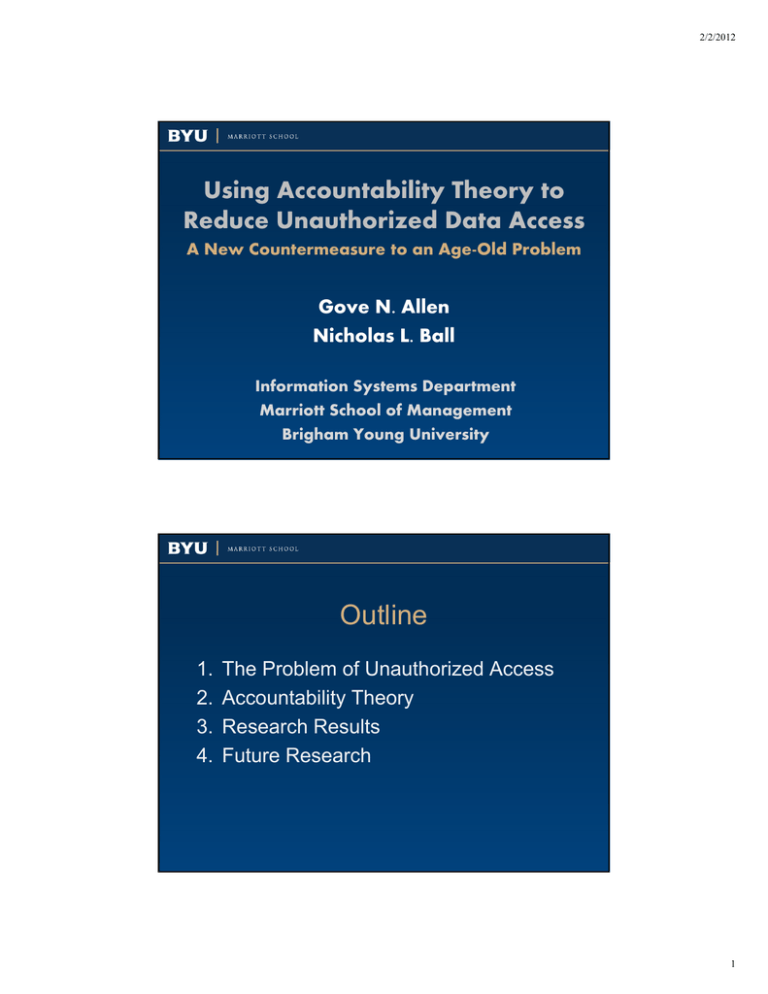
2/2/2012 Using Accountability Theory to Reduce Unauthorized Data Access A New Countermeasure to an Age-Old Problem Gove N. Allen Nicholas L. Ball Information Systems Department Marriott School of Management Brigham Young University Outline 1. 2. 3. 4. The Problem of Unauthorized Access Accountability Theory Research Results Future Research 1 2/2/2012 Allina Video Here Abuse of Power Abuse The problem of of Authority Unauthorized Data Access 2 2/2/2012 Abuse of Power Gary McKinnon: Disabled 2,000 U.S. Military Computers from Scotland Kevin Vladimir Mitnick: Levin: Robert Tappan Morris: Adrian Lamo: Jonathan Poulsen: James: Hacking is unauthorized Hacked into DEC, Citibank IBM, Created first computer worm system atand the Broke into phone NASA system and DTRA of L.New A. system access by Motrola, transferred NEC, Nokia, million Sun to released on$3.7 the Internet. Now York Times, Microsoft, radio stealing station software KIIS-FM worth toYahoo!, behis the Microsystems, own accounts Siemens, organization outsiders a CSMCI professor atwin MIT. and WorldCom. 102nd millions. caller He and was 16. a and others Porsche 944 Hacking Solution • • • • • User Training Penalty Hacker Gary McKinnon Case pending System Monitoring Robert Morris 3 years probation / $10,000 Technological Barriers Kevin Mitnick 5 Years in Prison Poulsen 5 Years in Prison / $65,000 CivilKevin Penalties Vladimir Levin 3 year in Jail / $240,000 Criminal Penalties Adrian Lamo 6 months house arrest / $65,000 Jonathan James 6 months in Prison 3 2/2/2012 Users have access Abuse ofgranted Authority privileges but institutional policy restricts proper access Motivation • • • • • • Public disclosure Power trip Identity theft Intellectual property theft Sale of private information Imprudent curiosity 4 2/2/2012 Vulnerable Systems • • • • IRS Have important or sensitive information Have a large number of records Have users with broad access authority Have many user of the system Tax Records Medical Records IRS employees terminated or Military Records Intellectual Property sanctioned for inappropriate Police Records Internet Services access (April 2009 – March 2010) Transaction Data Personnel Records 439 Internet Services Google Engineer, David Barksdale, was fired in July of 2010 after accessing call logs of a 15year-old acquaintance to find details about his girlfriend, then threatening to call her. 5 2/2/2012 Law Enforcement Records Tom Brady, N.E. Patriots Massachusetts, May, 2009. Ever wonder An audit of the state if database criminalhas records TomofBrady uncovered hundreds of a criminal queries about celebrities, record? including Brady, by personnel with no apparent work-related justification. Transaction Data Summer, 2010: an employee with Match Hospitality, the official ticket provider for FIFA, sold at least 250,000 records to black market ticket dealers. The records included the name, passport, and ticket information of customers who purchased tickets. The records sold for as much as 2.5 euros each. 6 2/2/2012 Intellectual Property November, 2007: Gary Min, a research scientist at DuPont was fined $44,500 for illegally accessing and downloading confidential documents worth almost $400,000 million. Military Records SIPRNet The “Private Internet” of the Department of Defense More than half a million users all with broad, unrestricted access. 7 2/2/2012 Private Bradley Manning Leaked hundreds of thousands of classified documents to WikiLeaks Manning’s 2010 Arrest May 21: Manning confessed to former hacker Adrian Lamo in an AOL chat room. May 23: Lamo met with FBI and Army officers and shows chat logs. May 26: Manning Arrested in Iraq. If Manning had not confessed, would his involvement been known? 8 2/2/2012 James Clapper Speaking on the Bradley Manning leak: "But in the end, our system is based on personal trust. We had an egregious violation of personal trust in this case. We've had them before. We'll have them again." National Intelligence Director Medical Records “There are just thousands of people who have access—and need to have access— to confidential information, and to try to change their behavior is a challenge” Donald Bradfield Johns Hopkins Health System 9 2/2/2012 Palisades Medical Center New Jersey After a motorcycle accident, more than two dozen employees illegally accessed Clooney’s medical records and those of his girlfriend, Sarah Larson. UCLA Medical Center Los Angeles 10 2/2/2012 California Health Privacy Law In 2008: • SB 541 Set health facility fines for breaches of privacy • AB 211 Holds healthcare providers accountable for ensuring the privacy of patients 2009-2010 Fines Hospital Kern Medical Fine 310,000 Patient Records 1+ Employees Involved 1 Bellflower Pacific Hospital $437,500 $225,000 1 9 23 1 San Bernardino Kaweah Manor $375,000 $125,000 207 1 2 5 Chico Delano Regional $130,000 $60,000 33 1 4 1 Marysville Oroville $100,000 $42,000 33 1 17 1 UCLA OC Children’s $95,000 $25,000 1 4 1 Bakersfield Brigs Gridley $25,000 $5,000 3 1 2 3 11 2/2/2012 Traditional Solution To the problem of unauthorized data access by insiders or abuse of authority . . . Principle of Least Privilege “Every privileged user of the system should operate using the least amount of privilege necessary to complete the job.” —Saltzer Communications of the ACM, 1974 12 2/2/2012 Problems with “Least Privilege” • Impractical for many organizations to implement effectively • Giving every employee the perfect level of access is problematic • Must choose to over-entitle or to underentitle Problems of Over-Entitlement • Undue exposure • Tendency toward escalation – Access rights are rarely revoked • Current estimates are that 50-90% of employees are over-entitled 13 2/2/2012 Problems of Under-Entitlement • Granting exceptions can be expensive and time consuming • In health-care settings, can be deadly • Can still lead to over-entitlement Even if the principle of least privilege were to be implemented perfectly, it cannot prevent the abuse of properly-accessed data. Implementing the principle of least privilege alone is insufficient 14 2/2/2012 Punitive Measures • • • • Sanctions Termination Civil Criminal Observation We tend to treat abuse of authority as we treat abuse of power. However, there is a fundamental difference. 15 2/2/2012 The implicit or explicit expectation that one may be called on to justify A new approach: one’s beliefs, feelings, and actions Accountability to others. —Lerner and Tetlock Parable of the Talents • The master gives each servant a stewardship. • The master travels to a “far country.” • After a “long time” the master returns and holds a reckoning 16 2/2/2012 Old Russian Proverb Doveryai, Trust, but no proveryai. verify. Accountability is not Surveillance Big George Brother Orwell is1790 watching Jeremy Panopticon Bentham 17 2/2/2012 Effects of Surveillance • Increases rule compliance • Decreases Employee Morale • Increases dissatisfaction Accountability Theory With the increase in the perception that an individual’s identity is known or that his actions will be evaluated, the behavior of that individual we be more consistent with social norms. 18 2/2/2012 Main Factors of Accountability A person’s “knowledge • Identifiability that his outputs could be • Evaluation linked to him.” —Williams et al. Trick-or-treat Study 19 2/2/2012 Evaluation “Performance will be assessed by another according to some normative ground rules and with some implied consequences.” —Lerner and Tetlock Areas of application • Psychology • Organizational Behavior • Marketing • Management 20 2/2/2012 Prior Accountability Findings Increasing accountability leads to: • Reduced norm-breaking behavior • Reduced risk-taking behavior • Increased job performance Accountability Theory is not Deterrence Theory 21 2/2/2012 Deterrence Theory Increasing the severity, certainty, or clarity of the consequences of an activity reduces the likelihood that an individual will engage in the activity. Prop. 1: Increasing the perception of identifiability reduces rule violation behaviorStudy: Empirical Prop. 2: Increasing the perception of the Research Report likelihood of evaluation reduces rule violation behavior 22 2/2/2012 Experimental Setting • Introduction to Java Programming • Online-homework submission system • 84 Students • One semester 23 2/2/2012 24 2/2/2012 Measurement Rule Violation Frequency: Each rule violation counts Rule Violation Instances: Rule violations are collapsed to the assignment level Hypotheses Results Control Experimental Groups Identity ID & Log Expect No Reduces Reduces Difference Violations Violations Identity Log Reduces Reduces Violations Violations Treatment 25 2/2/2012 Between Subjects Results Hypotheses P value Direction as expected? Supported? H1a: Instances of access policy violations will be less in the high identifiability condition than in the low. 0.016 Yes Yes H1b: Frequency of access policy violations will be less in the high identifiability condition than in the low 0.067 Yes Yes* H2a: Instances of access policy violations will be less in the high evaluation condition than in the low. 0.027 Yes Yes H2b: Frequency of access policy violations will be less in the high evaluation condition than in the low. 0.022 Yes Yes Within Subjects Results Hypotheses P value Direction as expected? Supported? H1c: Instances of access policy violations will be less in the high identifiability condition than in the low. 0.018 Yes Yes H1d: Frequency of access policy violations will be less in the high identifiability condition than in the low 0.025 Yes Yes H2c: Instances of access policy violations will be less in the high evaluation condition than in the low. 0.023 No No H2d: Frequency of access policy violations will be less in the high evaluation condition than in the low. 0.115 No No 26 2/2/2012 27 2/2/2012 What accounts for the increase of rule violation behavior in the last period? 28 2/2/2012 Implications of Research • Increasing perception of accountability affects user behavior • Increasing the perception of identifiability reduces rule-breaking behavior • Increasing perception of the likelihood of evaluation has a mixed effect 29 2/2/2012 Ongoing Future Research User Types Are there different types of people who behave differently under different conditions of accountability, as we saw in the last experimental period? Can these user type be predicted? 30 2/2/2012 Analysis of User Behavior in Control Group Saints 31 2/2/2012 Self Correctors Weakness of the Will 32 2/2/2012 Gradual Descent Recreants 33 2/2/2012 Other Research Topics • • • • • • • Effect of rolling log vs. static log Effect of log in isolation Manipulation of the likelihood of an audit Effect of making log public Effect of showing log to information owner Effect of random photograph Effect of biometric logging 34 2/2/2012 An altogether too brief History of Hacking Gary McKinnon McKinnon is Scottish systems administrator accused of the biggest military computer hacking exercise of all times by the US government. McKinnon is also accused of copying data, account files and passwords into his own computer. US authorities pegged the cost of tracking and rectifying the problems caused by his hacking at over $700,000. 35 2/2/2012 Robert Tappan Morris Morris is an American computer scientist, known for creating the first computer worm on the Internet called the Morris Worm in 1988. He became the first person convicted under the Computer Fraud and Abuse Act. He is a professor in the department of Electrical Engineering and Computer Science at the Massachusetts Institute of Technology. Kevin Mitnick Mitnick started out exploiting the Los Angeles bus punch card system to get free rides. He also dabbled in phone phreaking. Although there were numerous offenses, Mitnick was ultimately convicted for breaking into the Digital Equipment Corporation's computer network and stealing software. He is now a computer security consultant, author and speaker. 36 2/2/2012 Kevin Poulson Also known as Dark Dante, Poulsen gained recognition for his hack of LA radio's KIIS-FM phone lines, which earned him a brand new Porsche, among other items. Authorities began to pursue Poulsen after he hacked into a federal investigation database. During this pursuit, he further drew the ire of the FBI by hacking into federal computers for wiretap information. Jonathan James Also known as "c0mrade," James gained notoriety when he became the first juvenile to be sent to prison for hacking. He was sentenced at 16 years old. James's major intrusions targeted highprofile organizations. He installed a backdoor into a Defense Threat Reduction Agency server. James also cracked into NASA computers, stealing software. James said, "The code itself was crappy . . . certainly not worth $1.7 million like they claimed." 37 2/2/2012 Adrian Lamo Lamo's claim to fame is his break-ins at major organizations like The New York Times and Microsoft. Dubbed the "homeless hacker," he used Internet connections at Kinko's, coffee shops and libraries to do his intrusions. Lamo's intrusions consisted mainly of penetration testing, in which he found flaws in security, exploited them and then informed companies of their shortcomings. His hits include Yahoo!, Bank of America, Citigroup and Cingular. Vladimir Levin Vladimir Levin led a Russian hacker group in the first publicly revealed international bank robbery over a network. Levin used a laptop computer in London, England, to access the Citibank network, and then obtained a list of customer codes and passwords. Then he logged on 18 times over a period of weeks and transferred $3.7 million through wire transfers to accounts his group controlled in the United States, Finland, the Netherlands, Germany, and Israel. 38 2/2/2012 Caption: Title 39
